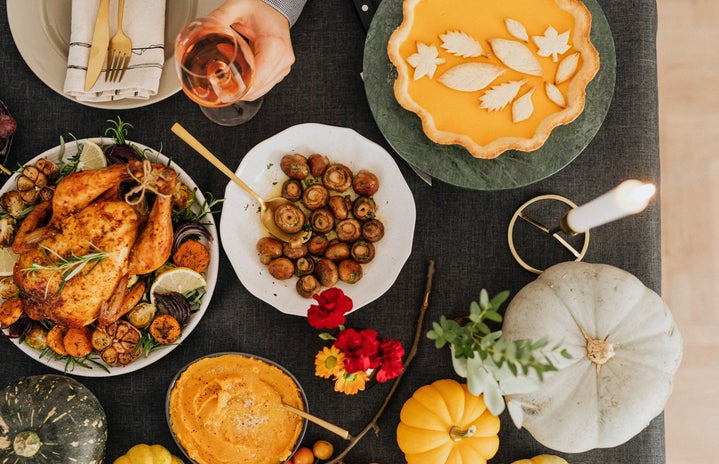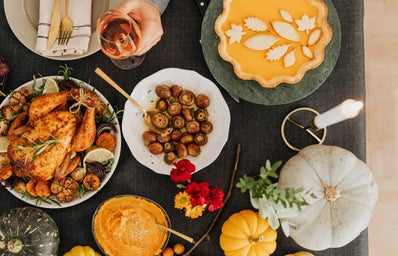Thanksgiving is associated with a host of traditions: a baffling fixation on turkeys, (American) football games and parades, Black Friday sales and stampedes, and heaps of pumpkin pie. The holiday’s extensive range of meanings and cultural implications can be difficult to navigate from an outside perspective—even Americans drastically vary in how they celebrate the holiday. So, I’ve compiled a list of everything to know about Thanksgiving as the fourth Thursday of November draws closer.
WHAT’S THE HISTORY BEHIND THANKSGIVING?
The “first Thanksgiving” marks the event which inspired Thanksgiving celebration today: when the Pilgrims and Wampanoag people gathered for a harvest banquet in November of 1621. The Pilgrims had previously traveled from England to Plymouth, Massachusetts in search for religious freedom and prosperity in the enigmatic “New World”. Soon after their arrival, an Indigenous tribe, the Wampanoag, helped the Pilgrims gather resources, tend to their illnesses, and settle into their new home. As a mark of their apparent alliance, the Pilgrims and the Wampanoag feasted for three days in America’s “first Thanksgiving”. Still, this presents an inappropriately glamorized version of the actual events of Thanksgiving and the Pilgrims’ relationship with Indigenous peoples.
WHY TURKEY?
One of the largest standing traditions in Thanksgiving is hosting a feast: more than anything, it’s an excuse to draw together friends and family and dine on an outrageously extensive meal. Traditionally, the menu includes mashed potatoes, gravy, green beans, cranberry sauce, corn, stuffing, dinner rolls, pumpkin pie, and, the crowning jewel—the turkey.
Turkey as the centerpiece of the holiday’s culinary tradition is mystifying. According to Harris Poll’s online survey of more than 2,000 adults, 68% of Americans, in actuality, dislike Thanksgiving food. While it’s becoming increasingly popular to diverge from the trademark turkey roast dinner, the tradition of eating turkey persists still. Even more mystifying is the fact that turkey was not even believed to feature in the Pilgrims’ original meal with the Wamponoag people. Historians believe that the only meat served was deer and wild fowl, which most likely refers to ducks or geese rather than turkeys. Still, turkeys are a convenient food resource: they’re abundant, always available on farms for slaughter, and large enough to feed an entire family for a feast. Still, it wasn’t until later that turkeys were closely linked with Thanksgiving. The biggest contributor to the turkey’s role in Thanksgiving is believed to be Sarah Josepha Hale, sometimes referred to as the “Mother of Thanksgiving”. Her novel, Northwood (1827) dedicates an entire chapter to describing a New England Thanksgiving, in which a roasted turkey was “placed at the head of the table”. She pushed for Thanksgiving as a national holiday at the dawn of the civil war as a way of fostering national morale and unity. Owing in large part to her continual effort, Abraham Lincoln proclaimed Thanksgiving a national holiday in 1863.
WHAT IS BLACK FRIDAY?
Black Friday is the Friday after Thanksgiving, where national chain stores typically offer drastic price deductions. It’s often associated with a mad rush to grab the best deals and snag the most cost-effective items before other shoppers.
The true origin of the name dates back to the 1960s, where police officers in Philadelphia coined the term “Black Friday”. They were forced to work extra-long shifts in an attempt to wrangle the hordes of crowds and frantic shoppers. In an attempt to more positively label the event, merchants attempted to change the name to “Big Friday”, but this didn’t end up sticking. However, a common misconception of the name, spread by merchants, is that “Black Friday” describes the turn in profit of many businesses: prior to Black Friday, businesses operate at financial loss, or “in the red”, until Black Friday, where their exponential increase in sales puts them “in the black”.
WHAT’S THE REAL HISTORY BEHIND THANKSGIVING?
Most importantly, however, Thanksgiving serves as a reminder to acknowledge the bloodied truth of the past: a hallmark of American culture, its defining purpose lies in celebrating the dawn of the Pilgrims’ America. Unfortunately, however, the oppression central to establishing America is too often overlooked and diminished. Immortalizing the holiday as a commemoration of the collaboration and goodwill between the Indigenous tribes and colonists is a massive failure within American education and culture. In actuality, Thanksgiving provides only a singular—and glamorized—perspective in a history fraught with genocide and oppression.
The colonizers were only successful in establishing Plymouth and the subsequent colonies because of their slaughter of the Indigenous tribes originally inhabiting North America. The Europeans who came four years before the Mayflower’s arrival carried foreign diseases with them, killing Indigenous people at increasingly high rates. Additionally, settlers explored North America with the intention of kidnapping Indigenous people and selling them into slavery. This paved the way for the colonists to settle into the land.
The “first Thanksgiving” was not the peaceful and generous gesture on the part of the Europeans that US history depicts it as: the Wampanoag Tribe had previously heard the Pilgrims shooting and declared an alliance with them to avoid conflict. This, however, would not last long. In following years, the Pilgrims celebrated “thanksgivings” in which they fasted and prayed; several of these events celebrated the massacres of Indigenous people including the murder of 700 Pequot people in 1637.
Thanksgiving is not indicative of any generosity or nobility within the Pilgrims, nor is it a mark of any kind of subsequent unification between Indigenous peoples and Pilgrims. It is, however, emblematic of the Wamponoag people’s generosity and hospitality and a reminder that America’s success came at the irreparable cost of thousands of Indigenous lives. It can be frustrating for many Indigenous people to see a holiday which marks the death of several of their people celebrated so casually and with such a distorted version of the truth.
This begs the question: is there one definitive, proper way to celebrate Thanksgiving? Given that it marks the beginning of a genocide and years of oppression, is it even moral to celebrate the holiday altogether? Well, Indigenous people celebrate the holiday in a number of ways: while some have taken to striking it from their calendars altogether, others use the day to mourn and remember their ancestors, while others take the day to spend time with loved ones. There’s no one way to celebrate Thanksgiving, but understanding America’s severely misunderstood history and listening to the marginalized communities it trampled on in its making and development is crucial. It is key to shift the holiday’s focus away from celebrating one of the United States’ largest humanitarian atrocities and focus on uplifting Indigenous stories and voices, while also practicing gratitude and spending time with friends and family.


